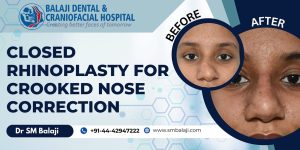The patient involved in a head-on car crash while on a work trip
The patient is a 26-year-old businessman from Pune in Maharashtra, India. About a year ago, he had driven down to a nearby city for work. While there, he was involved in a head on collision with another automobile. His head had impacted directly on the steering wheel resulting in extensive lower facial injury. He had not been wearing his seatbelt at the time of the accident.
He suffered a fractured lower jaw along with fractured teeth in both jaws. An ambulance had been summoned and he was immediately shifted to a nearby hospital. Imaging studies obtained at the hospital revealed bilateral body of the mandible fractures near the premolar region. He had also suffered fractures to maxillary and mandibular anterior teeth.
There were no injuries to his eye sockets and bone fractures to other facial structures. This type of injury is very common to unrestrained drivers. They can be life threatening and surgeons with special training are required to address these complex injuries.
Complications of malunion and infection with resultant loss of alveolar bone
An emergency surgery had been performed and his bilateral mandibular fractures had been stabilized with titanium plates. His fractured anterior teeth were also extracted.
Within a month after surgery, it became evident that the surgery had been poorly performed. Bilateral fracture fixation sites developed an infection. This resulted in extensive resorption of the anterior alveolar bone. The height of the alveolus was greatly reduced.
Referral to our hospital for management of complications of previous surgery
The patient presented at a local hospital for management of his problem. Imaging studies were obtained. The patient was informed that he had suffered from extensive alveolar bone loss secondary to the infection.
There was malunion of the fracture repair with infected plates. Postsurgical suturing had been performed poorly with resultant abnormal frenal attachments.
The patient and his family were counseled extensively regarding this. It was explained to them that his problem needed to be addressed at a specialty facial trauma care hospital. They were then referred to our hospital for treatment.
Anxiety of patient and his family allayed during initial consultation in our hospital
Dr SM Balaji, facial trauma care surgeon, examined the patient and ordered imaging studies including a 3D CT scan. There was malunion of the fracture along with reduced alveolar height. This had been caused due to the infection at the fracture site. There was also extensive loss of anterior teeth in both the maxilla and the mandible.
Treatment planning explained in detail to the patient and his family
It was explained that the patient’s infected titanium plates needed to be removed. This would be followed by reconstruction of the alveolar bone using bone grafts harvested from the patient. Nobel Biocare dental implants would then be placed for rehabilitation of the missing upper anterior teeth.
A period of six months would be allowed for bony consolidation of the graft to the alveolar bone. This would be followed by the placement of dental implants for rehabilitation of the missing lower anterior teeth.
Ceramic crowns would be placed on the dental implants following complete osseointegration of the implants to the surrounding alveolar bone. The patient and his parents were in complete agreement with the treatment plan and consented to surgery.
Successful completion of jaw reconstructive surgery for the patient
Under general anesthesia, an inframammary incision was made and a rib graft was harvested. A Valsalva maneuver was then performed to ensure that there was no perforation into the thoracic cavity.
Attention was turned to the maxilla where dental implants were placed in the anterior region. This was followed by a mandibular vestibular incision with the removal of the infected plates. The rib graft was then crafted to fit perfectly into the anterior alveolar defect. This was then fixed in place with screws and flaps closed with sutures.
Patient expresses understanding of postoperative instructions
The patient and his parents expressed their satisfaction with the treatment planning and the surgical results. They stated that they will return in six months for the complete rehabilitation of his oral structures.





